 Image search results - "d" Image search results - "d" |
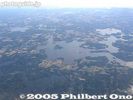
Finland: Land of Lakes 湖だらけの国When you look at a map of Finland or see it from the air, the first thing you notice is that it has a lot of lakes. Ten percent of the country is covered by lakes, but from the air over the southern half, it looks like least 30%-40% of the land is water.
It looked like a field of giant puddles or one giant marshland. It was like the country was sinking into ocean. I had never seen so many lakes in my life. Incredible. And if it's not water, it's forests. Some 70% of Finland is covered by forests.
I think Finland will someday become a popular tourist destination, especially for people who need to escape the urban hustle-bustle and stressful lifestyle. There are nothing like trees and lakes which can pacify humans.
Basic intro to Finland: http://virtual.finland.fi/
Finland map: Virtual Finland map
上空からも直ぐ分かるけど、フィンランドは湖がとっても多い国。20万弱の湖。面積の一割が湖。なんと国の7割は森林。湖と森林は、人を癒すものである。
HP: フィンランド政府観光局(日本語)
|
|

Letter of Thanks from PhilI really enjoyed my first trip to Finland during September 4-18, 2005 (Sept. 8-17 in Kuusamo) and savored every hour. The people in Kuusamo were all so nice and it was a great pleasure to meet and see the work of many talented and dedicated photographers from Europe.
They have definitely piqued my interest and opened my eyes to the nature and wildlife in northern Europe and the Arctic region. I've also become much more keenly aware of the seriousness of global warming. People in Finland have told me how the climate has become noticeably warmer over the decades. Such countries near the polar regions are the first to feel and see the detrimental effects of global warming. I really hope we can someday reverse the trend.
I want to thank the people who made my sponsored trip and participation in Kuusamo Nature Photo 2005 possible and very enjoyable. After months of email correspondence with the festival staff, it was great to finally meet all of them face to face. It makes a big difference when you know the face and person behind the name.
I know they worked very hard to pull off a very successful nature photo festival. For all the email correspondence, coordination, and making all the arrangements, I especially want to thank the following:
Lassi Rautiainen, Kuusamo Nature Photo Director
Pekka Pirhonen, Kuusamo Culture Department Manager
Seija Väisänen
Hannele Pappila
Town of Kuusamo
Corporate sponsors
I also want to personally thank the following people:
Pirkko Väätäinen, my interpreter who interpreted my three slide shows into Finnish.
Hannu Hautala and wife Irma, for having us over at his home/office. Despite his fame, Hannu is a very down-to-earth and warm-hearted man. It was a great pleasure to meet him, to see his collection of Japanese photo books, and hearing about his two trips to Japan.
Barbara, for videotaping my slide shows with my video camera and taking some great snapshots of me enjoying myself in Kuusamo. And also for providing transportation to/from the airport.
Tõnu Ling, for taking snapshots of me in Kuusamo and being my first friend in Kuusamo (we met on the plane to Kuusamo).
Koillis sanomat newspaper and reporter Tuomo Pirttimaa for interviewing me in an article they published.
Again, I have to thank Lassi for everything. He was the one who took care of all the details even during our nature trips. Lending sleeping bags, carrying hot drinks in heavy thermos bottles, driving us all over the place, answering all our questions, taking pictures of us, and making sure everyone had an enjoyable time. He turned out to be quite humorous. I can highly recommend him to anyone who needs a very knowledgeable local guide to watch or photograph wildlife in Finland.
See his Web site: Articmedia
Finally, I want to thank all the people and photographers I met at Kuusamo for their pleasant company and friendship. Remember that you have a friend in Japan. If you ever come and visit, let me know.
Meanwhile, I hope you enjoy this permanent online gallery of Finland photos explained in both English and Japanese.
Philbert Ono
Tokyo, Japan
P.S. In case you don't know, "kiitos" means thank you in Finnish.
|
|

Three-day (Aug. 9-11, 2006) rowing route around the southern half of the lake by the Kyoto Univ. rowing club.1st day: Home base in Seta River to Manohama (crew change), then to Omi-Maiko.
2nd day: Omi-Maiko to Manohama, then to Chomeiji.
3rd day: Chomeiji to Manohama where crew changes. Then to home base in Seta River.
|
|

My video of 2023 Koenji Awa Odori. 第64回高円寺阿波おどり
|
|

My video of 2018 Koenji Awa Odori 第62回高円寺阿波おどり
|
|

My video of 2017 Koenji Awa Odori (56 troupes) 第61回高円寺阿波おどり
|
|

My video of 2016 Koenji Awa Odori (56 troupes) 第60回高円寺阿波おどり 56連の総集編
|
|

My video of Koenji Awa Odori 2015 第59回高円寺阿波おどり 40連の総集編
|
|

My video of Koenji Awa Odori 2013 Part 1/3 第57回 東京高円寺阿波おどり 総集編
|
|

My video of Koenji Awa Odori 2013 Part 2/3 第57回 東京高円寺阿波おどり 総集編
|
|

My video of Koenji Awa Odori 2013 Part 3/3 第57回 東京高円寺阿波おどり 総集編
|
|

My video of Koenji Awa Odori 2011 Part 1/2 高円寺阿波おどり
|
|

My video of Koenji Awa Odori 2011 Part 2/2 高円寺阿波おどり
|
|

My video of Koenji Awa Odori 2009 Part 1/3 - Kokesaku 苔作
|
|

My video of Koenji Awa Odori 2009 Part 2/3 - Kikusui-ren 菊水会菊水連
|
|

My video of Koenji Awa Odori 2009 Part 3/3 - Asuka-ren 飛鳥連
|
|
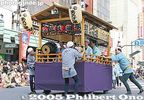
Sadly, the Tokyo Jidai Matsuri no longer held. It used to be held annually on Nov. 3 (Culture Day) in Asakusa, Tokyo.the Tokyo Jidai Matsuri (Festival of Historical Periods) is a parade tracing the history of Tokyo with over 1,600 people dressed in the respective period's costume. This is the lead float playing music. It took about an hour for the parade to reach Kaminarimon Gate.
Lead Float: Edo festival music played by children. Kodomo Edo-bayashi yatai
先導 子供江戸囃子屋台
|
|

Entrance and stairs going up to Shorinzan, a small hill. 少林山
|
|
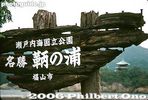
Sign for Tomonoura. Tomonoura is a National Important Traditional Townscape Preservation District (重要伝統的建造物群保存地区).
|
|

Sign for boat going to the islands (no longer in service)
|
|

Haneda to Tokushima
|
|
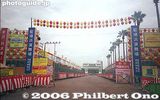
One of Japan's grandest festivals, the Tokushima Awa Odori is a summer dance performed in central Tokushima city. Numerous dance troupes called "ren" appear in a long parade along the city's main streets for four evenings in mid-Aug. About 2 million people see it during the four days it is held. It is like a bon dance to greet the souls of the deceased returning to visit. There are other Awa Odori festivals in Japan, but the one in Tokushima is the original and largest one. "Awa" is the former feudal name of Tokushima. Photo: Entrance to one of the spectator areas called "embujo" (admission charged). 藍場浜演舞場
|
|
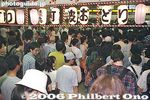
Crowd at JR Koenji Station on Awa Odori night.The Koenji Awa Odori is basically a parade of dancers. Many groups of dancers from various parts of Japan participate in the parade that follows the main shopping streets near Koenji Station on the Japan Railways Chuo Line in Tokyo.
|
|

Kenrokuen is one of Japan's three most famous gardens (besides Korakuen in Okayama and Kairakuen in Mito, Ibaraki). The garden was originally the castle garden for Kanazawa Castle. Katsurazaka Entrance to Kenrokuen Garden 桂坂口
|
|

April 8, 2006 at Ushigome-Tansu Kumin Hall in Kagurazaka, TokyoStarting at 4 pm, this was the third and last show of the day and all 400 seats were sold out.
The performance had two parts separated by a 20-min. intermission. Each part had several different dances.
|
|

Before 8 am: Women do a warm-up lap.It wasn't exactly warm, but they had wet suits. Odaiba's water is not exactly crystal-clear clean either.
|
|

Established in 1617, Tsukiji Hongwanji temple is the Tokyo headquarters of the Nishi Hongwanji Jodo Shinshu sect. The present temple, based on Indian architecture, was built in the 1930s.The temple is the only one in Japan which is under the direct control of the sect. Its head priest is the Monshu Abbot himself. April 8 is observed as Buddha's birthday, called Hana Matsuri ("Flower Festival) in Japan.
|
|

Yasukuni Shrine is Japan's most prominent shrine for the war dead. Near Kudanshita Station on the Tozai Subway Line. This is the first giant torii
|
|

PR poster for the Kamogawa Odori geisha dance held during May 1-24 in Pontocho.
|
|

Yasukuni Shrine during the Mitama Matsuri before dark.
|
|

Kanagawa Prefecture's largest Awa Odori is held annually during the last weekend in July in this city of Yamato. Preview event near Yamato Station.
|
|

Road marker. Established in 1642, Moriyama-juku was the sixty-seventh of the sixty-nine stations or shukuba post towns on the Nakasendo Road. It is the eighth Nakasendo station in Shiga (following Musa-juku in Omi-Hachiman).
|
|

Three boats are used for the trip, sighted here off shore near JR Hira Station on the Kosei Line. 湖西線比良駅の沖
|
|

Nose Myokenzan Betsuin at a street corner. In Feb., priests at this small temple splash cold water on themselves for 30 min. Near Honjo-Azumabashi Station on the Toei Asakusa Line or JR Kinshicho Station on the Sobu Line.
|
|

Tokyo Dome on March 3, 2006, the first day of the WBC's Asian Round.
|
|

Welcome to IbarakiTrain platform of Kairakuen Station.
|
|

To Tokyo Big Sight
|
|

Well-wishers look on as rowers embark for the race taking place at the same venue where the rowing competition was held at the 1964 Tokyo Olympics.
|
|
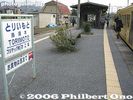
Toriimoto-juku is the sixty-third of the sixty-nine stations or shukuba post towns on the Nakasendo Road. It is the fourth Nakasendo station in Shiga (following Bamba-juku in Maibara), and one of ten Nakasendo stations in Shiga.
|
|

At 2 pm, the 18 portable shrines gather at the Ohara Fishing Port. 大原漁港に参集
|
|

The outdoor architectural museum is within Koganei Park in Koganei, Tokyo. This is the Visitors Center.
|
|

Bird's eye view of Shirakawa-go from Ogimachi Castle ruins.
|
|

Side view of Wada-ke House
|
|

The Kokugikan as seen from JR Ryogoku Station platform.
|
|

Monorail to Chiba Koen Station 千葉公園駅
|
|

Gate to Kitain, a Tendai Buddhist temple. Part of Kawagoe's National Important Traditional Townscape Preservation District (重要伝統的建造物群保存地区).
|
|

From late April to early May, five long strings of giant carp streamers swim in the air high above the Sagami River in Sagamihara, Kanagawa. This event was started in 1988.
|
|

The biggest taiko drum festival in the Kanto region is held annually in April. Various taiko drum troupes perform for two full days on various outdoor stages in Narita, including the main stage in front of the Narita-san temple.
|
|
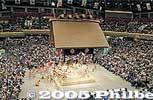
More people than the real tournamentAbout 8,000 people took time out from their Golden Week holidays to see this official sumo practice of all sumo stables.
|
|

One of two giant kitesThis festival has two giant kites and two smaller (but still large) kites. Resting on its side, the kite was scheduled to fly at 2 pm. The kanji characters read "Michi no Eki" in reference to a new train station built in the town.
|
|
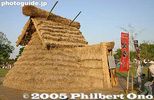
Festival's focal pointThis grass hut is at the center of the festival site which is within the Sakitama Tumuli Park. It will be burned later in the evening for the festival's climax.
|
|
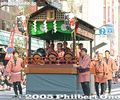
This page is a complete English guide to all the groups that appear in the parade. The parade assembles behind Sensoji Temple and starts at 1:30 pm from Nitenmon gate. The procession then goes down Umamichi-dori street, passes by Matsuya Department Store.先導 子供江戸囃子屋台
|
|

Shirakawa-go is also a National Important Traditional Townscape Preservation District (重要伝統的建造物群保存地区).
|
|
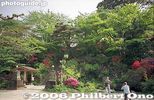
Garden
|
|

Ferry between Tomonoura and Sensui island.
|
|
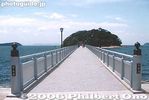
400-meter long bridge to Takeshima island near JR Gamagori Station. The island is made of granite. Circumference is 680 meters. There's a walking path around the island.
|
|

Rabbit Island
|
|

The festival is held along a straight, 800-meter section of San'o Odori Road, a 20-min. walk from Akita Station.In the evening, the main event starts at 6:38 p.m. with a taiko drum-beating performance or minyo dancers on San'o Odori Road. At 7:17 p.m., some 200 kanto are carried into the street to the sound of flutes and taiko drums. At 7:40 p.m. following a brief address by the city's mayor, the performance begins as the kanto are raised all at once.
|
|
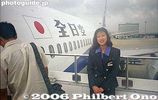
Hi Philbert! Welcome aboard!
|
|
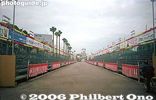
Spectator seats. Admission is 1,000 to 2,000 yen.
|
|

Each dance troupe starts with a lantern bearer showing the name of the troupe.The dance is quite simple. While bobbing up and down, the dancer holds her hands above the head and shakes the fingers. This hand gesture indicates that the person has gone crazy. It is therefore nicknamed the "fool's dance." The dance is held on the last weekend in August.
|
|

Part 1 - Edo Scenes (江戸風情): 1. Fuji Murasaki (Purple Wisteria) 藤むらさきDancers: 小奴、千佳、由良子、舞子
|
|

Women at the starting line for triathlon
|
|

Kenrokuen is classified as a "kaiyu-shiki teien" (回遊式庭園) or "circular-strolling Japanese garden." It's a common and classic Japanese garden design where you simply walk around the garden, usually around a central pond.
|
|

Tsukiji Hongwanji temple gate with wisteria crest.The emblem is a wisteria flower and symbol of the Jodo Shinshu sect.
|
|

Path to shrine
|
|

Pontocho Kaburenjo theater, venue for Kamogawa Odori.
|
|
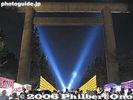
Yasukuni Shrine's main torii during Mitama Matsuri
|
|
|
|

Road marker. Go right for the Nakasendo Road. MAP
|
|

Arriving Omi-Maiko on Day 1. Rowing around the lake has been an annual tradition.
|
|

Shrine hall
|
|

Tokyo Dome
|
|

Finish line end of the 2000-meter Toda Boat Course.
|
|

Train platform of Kairakuen Station
|
|

Entrance to Tokyo Big Sight
|
|
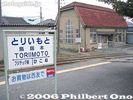
Although the Honjin is long gone, there are a few reminders of its shukuba past. Near Ohmi Railways Toriimoto Station. Map
|
|

They run around while carrying a portable shrine.
|
|

Going to visitors center
|
|

Path to Wada House entrance
|
|

View of Chiba Park from monorail. 綿打池
|
|

Kitain Main hall, Kawagoe
|
|

Pulling the float, Narita Gion Matsuri
|
|

There are five rows of streamers. In Japan, the koi carp is regarded as a symbol of valiant manhood because it swims up the river against the rapids.
|
|
|
|
|
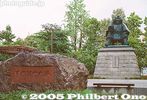
Park in front of Kofu Station.
|
|
|

Offerings
|
|

From Matsuya Department Store, the procession turns right into Kaminarimon-dori street which passes in front of the famous, giant red lantern called Kaminarimon Gate. Lead float with Edo festival music played by children. 先導 子供江戸囃子屋台
|
|
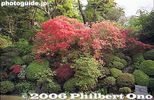
Garden (photos taken in early May)
|
|
|

Rabbits
|
|

Crowds already line Tokushima's main street soon to be closed to traffic.
|
|
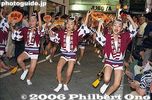
The troupe can consist of children (as young as age 2 or 3), women, and men.The Awa Odori originated 400 years ago in Tokushima Prefecture (in Shikoku) where it is one of Japan's most famous festivals. Although it is not as large as the one in Tokushima, the Koenji Awa Odori in Tokyo has become a major summer festival in Tokyo.
|
|
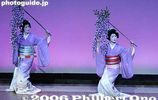
1. Fuji Murasaki (Purple Wisteria)
|
|

Kasumigaike Pond and the famous Kotoji-toro stone lantern. The lantern is shaped like a bridge that supports a string on the koto instrument. 霞ヶ池 徽軫灯籠
|
|

Temple gate and flag
|
|
|

Pontocho is a narrow alley and known as a geisha district.
|
|

Promenade to the shrine
|
|

Pre-festival event held in the afternoon, Yamato Awa Odori
|
|

Rear of road marker
|
|
|

Barrels of cold water in front of shrine
|
|

Front entrance to Tokyo Dome. Japan plays its first WBC game and the opponent is China.
|
|

End of the Toda Boat Course, near the 2000-meter finish line.
|
|

Train platform of Kairakuen Station
|
|

Photo Imaging Expo 2006 sign
|
|
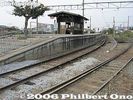
Ohmi Railways Toriimoto Station platform
|
|
|

Close-up of Ogimachi
|
|

Visitors Center entrance courtyard
|
|

Main house on left and latrine on right with large vats to gather fertilizer.
|
|
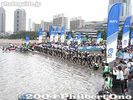
Starting line
|
|

Looks like Suganuma, another village in Gokayama area.
|
|

Chiba Park approach
|
|

Children lead the way for a float at Kawagoe Festival.
|
|

Main hall
|
|

Tired from walking, Narita Gion Matsuri
|
|

The cable length is 250 meters and 13mmm thick. There are about 1,200 carp streamers. They are reused every year and donated by local families. (I also noticed a few advertising carps.)
|
|
|

Yokozuna Deliberation Council membersIn the middle is Kitanoumi.
|
|

Statue of Takeda Shingen.
|
|
|
|

Festival siteIt is a circular site with people sitting along the perimeter.
|
|

Lead float with Edo festival music played by children. The names of the children playing are written on the red lanterns hanging above. Kodomo Edo-bayashi yatai 先導 子供江戸囃子屋台
|
|
|
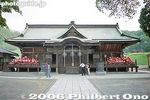
Shorinzan Daruma Temple 少林山達磨寺Daruma offerings on both sides of the temple.
|
|

Shinkyo Sacred Bridge, Nikko 神橋
|
|
|

Feeding a rabbit
|
|

These photos were taken in Aug. 1999.
|
|

The Koenji Awa Odori has become a major summer festival in Tokyo. It had a humble beginning in 1957 when it was originally called the Koenji Baka Odori. "Baka" means fool.
|
|

1. Fuji Murasaki (Purple Wisteria)
|
|

8:10 am: And they're off, taking about 30 min. to swim 1.5 km.
|
|

Famous Kotoji-toro stone lantern 徽軫灯籠
|
|

Play room for kids on Hanamatsuri
|
|

Statue of Omura Masujiro (1824-1869) 大村益次郎, founder of Japan's modern army. Also pushed for the establishment of Yasukuni Shrine.
|
|

Dance program for 2005.
|
|

Spotlights create a silhouette of the statue of Omura Masujiro (1824-1869) 大村益次郎, founder of Japan's modern army.
|
|
|

Marker for the Kabuto-ya inn
|
|

They use four-man boats (called "knuckle four" in Japanese) with sliding seats. It is stable and safe, ideal for beginners.
|
|

Barrels of cold water
|
|

Chinese team is introduced.
|
|

Housing for visiting rowing teams whose school flags are displayed.
|
|

Plum Blossom Queen at Kairakuen StationShe was passing out maps of the garden. It was a nice touch to see two of these kimono beauties greeting us.
|
|

Hallway
|
|

Ohmi Railways Toriimoto Station building
|
|

They keep going round and round. Quite rowdy.
|
|
|

Main house with a recently rethatched roof, making it look very smooth.
|
|
|

Pagoda at Kitain temple, Kawagoe
|
|

Sekigahara saw one of Japan's most pivotal battles on Oct. 21, 1600 (Sept. 15 of Keicho 5) between Tokugawa Ieyasu's Eastern Forces and Toyotomi Hideyoshi loyalist Ishida Mitsunari's Western Forces. Ieyasu's victory in the Battle of Sekigahara sealed Japan's historical fate for the next 250 years. The former battlefield is dotted with monuments indicating the positions of various warlords during the battle.
This photo shows Mt. Momokubari where Tokugawa Ieyasu first set up his base camp for the Battle of Sekigahara. It is next to busy Route 21. A short distance east of Sekigahara Station. The former Sekigahara battlefield has numerous monuments.
|
|

Banners and a monument mark the spot on Mt. Momokubari where Tokugawa Ieyasu's first base camp was established during the Battle of Sekigahara on Sept. 15, 1600.
|
|

Ieyasu and his troops were here from about 6 am to 10 am on the day of the Sekigahara battle. He later moved closer to the front line as the battle was going his way. This is a National Historic Place. 桃配山 徳川家康最初陣跡
|
|

Steps going up to Tokugawa Ieyasu's first base camp at Momokubari during the Battle of Sekigahara on Oct. 21, 1600 (Sept. 15 of Keicho 5). Today it's just a small hill. The highway seemed to have cut through most of it.
|
|

Steps going up to Tokugawa Ieyasu's first base camp during the Battle of Sekigahara.
|
|

At the top, see the two large rocks which served as a table and bench for Ieyasu. 家康の腰掛岩と机石
|
|

Monuments marking Tokugawa Ieyasu's first base camp during the Battle of Sekigahara. The banners have the Tokugawa family crest.
|
|

View of the Sekigahara battlefield from Tokugawa Ieyasu's first base camp at Momokubari.
|
|

Monument marking Tokugawa Ieyasu's first base camp during the Battle of Sekigahara.
|
|

Another smaller monument marking Tokugawa Ieyasu's first base camp during the Battle of Sekigahara.
|
|

Sign explaining that the two rocks below were said to be used as a bench and table for Ieyasu.
|
|

Behind the monuments is a trail probably used by Ieyasu's troops on Mt. Momokubari-yama.
|
|
|
|
|
|

Lowering the kite
|
|

SpectatorsThese people are sitting in the best area to view the festival.
|
|
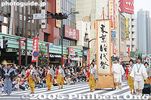
Tokyo Jidai Matsuri Banner and Tekomai geisha. From top to bottom, the banner reads, "Tokyo Jidai Matsuri." It marks the official and real start of the festival parade. The first Tokyo Jidai Matsuri was held in 1989. 東京時代祭本旗The first Tokyo Jidai Matsuri was held in 1989. Slight changes in the festival have been made since. Instead of two oiran courtesans, there is only one now. And at the end of the parade, the Asakusa Revue of showgirls used to be the anchor. But they are now gone.
東京時代祭本旗、手古舞
|
|

An Australian praying at the temple
|
|
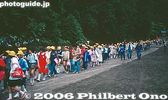
Kids on school trip along Omotesando 表参道
|
|
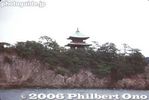
Bentenjima island near Tomonoura.
|
|
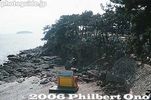
Rabbit Island
|
|
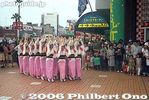
Pre-festival warm-up performance.
|
|

1. Fuji Murasaki (Purple Wisteria)
|
|
|

Hanamatsuri altar
|
|

The strolling path is not a perfect circle, but you start and finish at the same point. The strolling path is lined with Japanese pines, flowering plants, maples, etc.
|
|
|

The procession basically consists of two columns: The Hon-retsu which includes the procession's highest-ranking official called Chokushi. It consists of men. The second and longer column is the Saio-dai-retsu consisting of women.
|
|
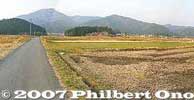
Panoramic view of where the Battle of Sekigahara started. Most battle monuments are within walking distance from the train station, but they are numerous and spread over a wide area.The battle started at the foot of the hill on the left of the road. The small hill on the right was where Shimazu Yoshihiro was stationed. Mt. Ibuki is in the background in the middle.
|
|

Barrels of sake next to the theater.
|
|

A bon dance around the base of the statue.
|
|

Shimizu Bank
|
|

Yamato Station
|
|

Entrance to Urakuen GardenThis garden has a few tea houses including one called Jo-an, a National Treasure. THe garden is close to Inuyama Castle and worth a visit. Admission 1,000 yen.
有楽苑
営業時間 9:00〜17:00(3/1〜7/14 ・ 9/1〜11/30)
9:00〜18:00(7/15〜8/31)
9:00〜16:00(12/1〜2/末日)
休日 無休 入場料 大人1,000円(呈茶別500円)
〒484−0081
愛知県犬山市御門先1
TEL 0568(61)4608
交通 名鉄犬山線犬山遊園下車徒歩7分
|
|

Old Nakasendo Road and Dobashi Bridge. Supposedly, this is the bridge from where Hiroshige drew his print of Moriyama-juku.
|
|

Each boat has four rowers and cox who steers the rudder.
|
|

The congregation gather on the steps and beat fan-shaped drums.
|
|

Japan's National Anthem is played.
|
|

Plum Blossom Queen
|
|

Boat landing near finish line.
|
|

To PIE 2006 held in late March.
|
|

One trademark of the dancers is the crescent-shaped straw hats.
|
|

Ohmi Railways Toriimoto Station building
|
|
|

Shirakawa-go 白川郷
|
|
|

Wada House, Shirakawa-go
|
|

Entry road to Ainokura village. Bus stop shelter on right.
|
|

White weeping cherry blossoms
|
|
|

The floats were jerked left and right and spun around.At 7:00 p.m., the taiko drum-beating started and the floats left the starting point one by one. The beat of the taiko drums was the same as that in the Nebuta Matsuri. A few men stood on the top of the large Neputa and collapsed the hinged, top portion to clear overhead power lines. The floats were jerked left and right and spun around.
|
|
|
|
|

Preparing unagi eel, Narita, Chiba. Also see the video at YouTube.Slicing it in half lengthwise.
|
|

Sumo elders in the front row
|
|
|

EntertainmentAn outdoor stage provides a variety of entertainment during the day.
|
|
|
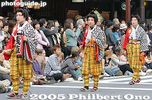
Tekomai geisha existed since the Edo Period. They served as side entertainment at festivals. They only sing traditional chant-like songs called kiyari originally sung by lumberers hauling wood. 手古舞These tekomai did not sing, so they might not be real. When they sing, they hold a fan to their mouth.
手古舞
|
|
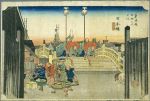
Hiroshige's woodblock print of Nihonbashi from his "Fifty-Three Stations of the Tokaido Road" series.
|
|
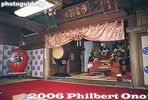
Inside the Daruma temple, Takasaki.
|
|
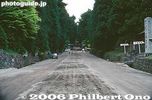
A National Treasure and World Heritage Site, Nikko's magnificent shrines and temples overshadow any other attractions Tochigi has. The Toshogu Shrine is especially famous and also serves as Tokugawa Ieyasu's mausoleum. Omotesando 表参道
|
|
|
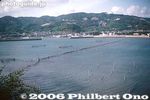
View from Rabbit Island
|
|
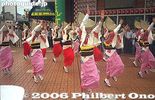
This was in front of a dept. store near Tokushima Station.
|
|
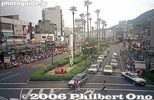
Shinmachi-bashi road in front of Tokushima Station 新町橋通りIt was Awa Odori time.
|
|

1. Fuji Murasaki (Purple Wisteria)
|
|
|
|
|

Pouring sweet tea over the BuddhaWhen the Buddha was born in Lumbini Garden in Nepal, sweet rain is said to have fallen. Thus, sweet tea is poured over the baby Buddha statue in the Hanamatsuri altar.
|
|

Second torii
|
|

The battle started at the foot of the hill on the left of the road. The small hill on the right was where Shimazu Yoshihiro was stationed. Mt. Ibuki is in the background in the middle.
|
|
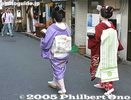
A geisha/geiko and maiko head to the theater to see the Kamogawa Odori. Notice the different obi sash on the back.A maiko is an apprentice geisha. Her obi sah on the back is long, as well as her sleeves.
|
|
|

Balloons, souvenirs and trinkets sold near the train station.
|
|

Dobashi Bridge
|
|

The green boat. 近江舞子上陸
|
|

Priests appear
|
|

Tommy Lasorda after throwing the flubbed first pitch.He just threw the ball right on the ground like he wanted to throw it away. It wasn't a pitch at all. What was his problem?
|
|

Hosei Univ. cheering section on the first day (Aug. 24, 2006) of the 33rd All-Japan Intercollegiate Rowing Championships.
|
|

Entrance to garden via Tokiwa Shrine. One of Japan's three most famous gardens, Kairakuen is especially noted for thousands of plum blossom trees which bloom in Feb. and March.One of Japan's three most famous gardens, Kairakuen is especially noted for thousands of plum blossom trees which bloom in Feb. and March.
|
|

PIE 2006 ticket booth
|
|

Carving daikon. Anybody can join in and carve. 大根削りLater to be auctioned off.
|
|

The men look more like the "fools."
|
|
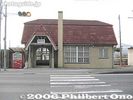
Toriimoto Station building built in 1931 when the station opened and still in use.
|
|

A man who got bumped and fell is quickly brought to his feet by other people.
|
|
|
|

Jisho-in Mausoleum
|
|

Way to Ainokura.
|
|

White weeping cherry blossoms
|
|
|
|
|
|

Striping off the boney spine.
|
|

Former yokozuna Taiho, Takanosato, Kotozakura, and Wakanohana watch intently.
|
|
| 34476 files on 137 page(s) |
1 |
 |
 |
 |
 |
|